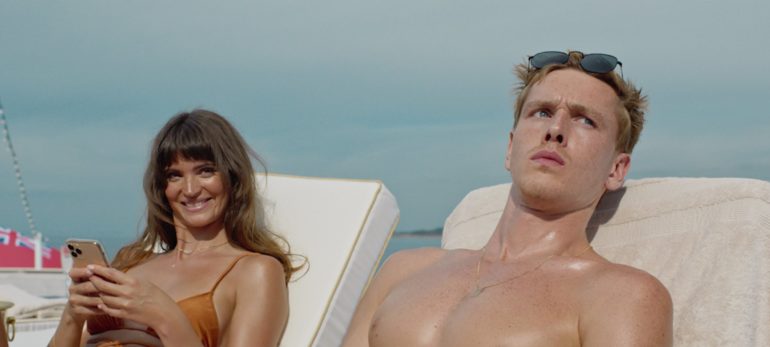The secret of comedy has always been timing. Any comic will tell you that choosing the moment for the punchline to land is the key to whether the joke works. Apparently, no-one told Ruben Östlund. The Swedish filmmaker has a particularly blunt approach to his joke construction. If the first act of his film is the setup, what remains is a punchline barrage, repeating the point ad nauseum in case you didn’t get it the first time. This approach works well for some audiences, as evidenced by Östlund’s two Palmes d’Or. His second win, the polished Triangle of Sadness is ‘satire’ with a capital ‘S’ and flashing bright lights. It’s making a point, and it wants you to acknowledge that.
To give credit where it’s due, Östlund does have an eye for a great setup. Opening at a runway audition for a bevy of shirtless male models, the writer-director plays up simple laughs as an interviewer has the models switch between their stock poses (Balenciaga frown, or H&M laughter) on a dime. It’s too easy to laugh at the world of high fashion, but we’re given an interesting prism through which to see it. One of the models, Carl (Harris Dickinson, turning up the likeability to counter his lack of body fat), is not doing as well as he might have imagined from this career. An early highpoint sees Carl and his girlfriend, fellow model Yaya (Charlbi Dean, whose premature death lends a sadness to… er, Triangle of Sadness), begin to bicker about which should pay in a restaurant. He’s the man, but she makes more. The fact they’re models renders the exchange laughable, but strip away that excessive sheen, and there’s something relatable in their financial woes. These mid-to-late millennials weather the same storms as their kin, and don’t let their perfect skin and toned abs fool you otherwise. Yaya is an influencer, but is dependent on the handouts of sponsors to maintain the façade. Faking it is hard work, and the leads, balancing their sniping with vulnerability, help Östlund ground Triangle of Sadness in this reality. It’s a fine line he walks, with the characters living in an ever-so-slightly heightened reality. Carl’s audition takes place in an undecorated yet pleasingly-framed and beige prefab nightmare, reminiscent of another winking Swede, Roy Andersson. Alas, our focus is about to shift away from any sense of what is real, and will plunge further into Andersson-land, into the downright farcical.
As their latest freebie, Carl and Yaya take a cabin on board a luxury yacht, populated by a bunch of first-class snobs with whom to hobnob. Of course, that’s only half the story. We are introduced to the uniformed crowd-facing crew, led by over-eager Roxette doppelganger Paula (Vicki Berlin). All are young and pristine, and on the hunt for a handsome tip. Perhaps this is why Carl and Yaya seem to disappear for long stretches of Triangle of Sadness’ flabby midsection. If Act One (‘Carl and Yaya’) gave us unlikeable but relatable characters, Act Two (‘The Yacht’) renders us subject to a Stygian barrage of wealthy morons, broad in caricature and devoid of nuance. According to Östlund, the collective mindset of audiences circa 2022 must be so devoid of nuance that signifiers of satirical intent must be underlined. There’s the elderly British couple who own a weapons manufacturing company; naturally, they’re named Winston and Clementine. Then there’s Dimitry (Zlatko Burić), the bloating Russian oligarch with wife and mistress in tow. At one point, when Carl asks what he does for a living, Dimitry declares “I sell shit!” Triangle of Sadness couldn’t be accused of subtlety; as a writer, Östlund never met a metaphor with which he couldn’t bludgeon an audience into submission. As we spend time with these monied dolts, pretense and restraint gradually ebb away, as the passengers are gifted all and every champagned whim, to the point that an incoming storm causes dinner table expulsions on a par with Mr. Creosote in Monty Python’s The Meaning of Life. As much as we might like to see the snobs get their comeuppance in these situations, the second act of this voyage goes on far too long. At one point, we glimpse the yacht’s bridge, obviously unmanned to hammer home the point. The whole Bacchanal badinerie is overseen by Woody Harrelson’s drunken depressive captain, who lets loose his inner Marxist after a few whiskies. The scenes in which the captain and Dimitry jokingly dissect their respective economic outlooks are the film’s nadir; you won’t care who’s a capitalist or a communist, so long as they just shut up. Watches will have been flashed in the crowd by the time an unexpected (Read: entirely predictable) twist to the yacht’s tale comes along. Triangle of Sadness simply drains passengers, crew and audience alike, but sadly, we’ve not come into port yet.
Act Three (‘The Island’) sees the yacht’s inhabitants plunged into Lord of the Flies territory. To say much more risks jeopardizing some of the hard-earned laughs the film remembers to bring, most of them courtesy of Dolly DeLeon’s Abigail, one of the lower rungs of the yacht’s cleaning crew. Still, for all the zaniness Östlund purports to bring to bear, you know where this is going. The last shall be first, and the first shall be humbled, and the newly-empowered last will probably be corrupted. It’s a pity Triangle of Sadness is so obvious, because it’s handsomely made, and Östlund is a cannier and wittier director than he is a writer. Some of the obvious punchlines here could have been delivered with a clever cut or camera move rather than the blunt writing to which Östlund reverts. By the time the end of Triangle of Sadness rolls around, the game performances and visual technique will be overwhelmed by the blunt force trauma of being beaten about the head by its message. After all the vomitus produced here, eating the rich seems like less than an appetizing prospect.

